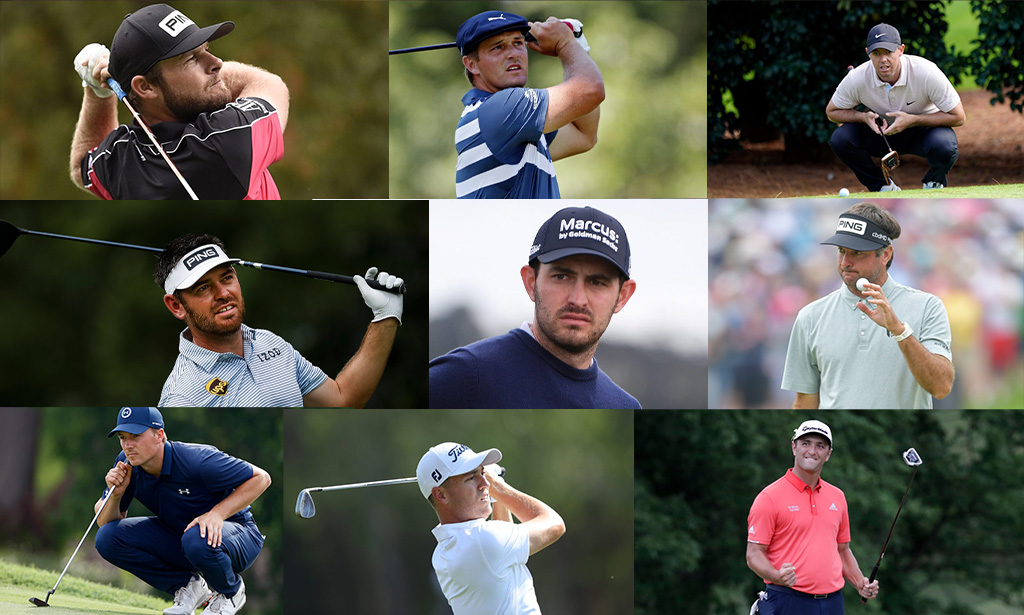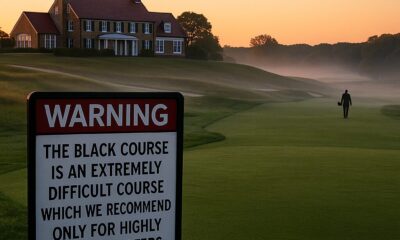Blog
Our Favorite PGA Tour Players to Watch – and Some We’d Skip

Most PGA Tour events are kind of like a two for one deal. The first two rounds begin on Thursday and golfers must make the cut in order to continue on in the event. This is proceeded by the big weekend excitement that golf fans are sure to be near a television to watch. Plus, that prize money is nothing to turn your nose up at either. This is the pros after all. Top earners are walking away with seven figures, easy.
Of course, all of that big money would not be possible if it weren’t for the network broadcasts. As we’ve especially learned during Covid, televised sporting events hold a lot of value. With even more golf fans tuning in from the comfort of their living room, they are willing to pay for that subscription to be able to tune into the action. The PGA Tour’s relationship with networks is more important than ever. The golfer’s themselves don’t come close to bringing in enough money to even touch the payout that live coverage can provide.
The only pro who could claim that title is Tiger Woods. After his horrific car crash at the beginning of the year, we haven’t seen much of the GOAT. He hasn’t even announced plans to come back any time soon.
Whereas Thursday and Friday’s rounds offer a rapid-fire succession of golf shots to viewers, Saturday and Sunday take on a very different dimension. The focus shifts to those atop the leaderboard. This is where we really get to know the golfers. How their facial expressions tell us a little about what is going on inside their head. The shifts in their body language when they are feeling the pressure. We really get to know their quirks. If a player is doing particularly well, TV cameras will have us invested in on player for well over an hour.
As a disparate audience, we draw conclusions. These are based on our own experiences and despite our lack of professional training. We judge the players based on this persona that we have been deciphering on TV. Because some players are easier to like than others, whether that appeal comes from a swing full of power and grace, an everlasting smile, some crowd interaction or a simple appreciation for one’s intense determination.
As a result, we are able to read the golfer’s thoughts and feelings closer than other professional athletes we analyze from our couch. With some invaluable help from a half-dozen pairs of eyeballs and my own marginal sense of perspective, what follows is an assessment of nine marquee players, each of whom has been assigned a “watchability” rating. Using the Bo Derek scale (10 for best, 1 for worst), our subjects are graded for their on-course deportment and assorted observational factors that add to (or detract from) the viewing experience.
This is not a ranking. Just a subjective look at the men who make the game so interesting.
Rory McIlroy — 9 out of 10

The victory in Vegas last weekend makes Northern Ireland’s finest the perfect leadoff hitter. McIlroy maintains a rapid pace of play that a lot of other golfers on Tour can’t match. He makes some ridiculous course-management decisions at times, but that’s not a negative. When things are going well, he jaunts down the fairway like a 9-year-old kid. When they’re not, he wears it on his face like few others. Sadness, not anger. He is incapable of gloating or showboating. Polite but outspoken. Two steps above gifted but flawed beyond explanation. A wonderful asset to the game and one of the more enjoyable players to watch.
Patrick Cantlay— 6 out of 10

His businesslike approach obviously paid off handsomely in 2021, although I prefer the fiery, fist-pumping version of Cantlay we saw at the Ryder Cup. He is unabashedly slow on the greens, and that shuffle of his feet over a putt can leave a fella feeling seasick, but he holes so many bombs that you feel thankful he won’t need another 90 seconds to knock in the next one.
Jordan Spieth — 5 out of 10

He talks to his golf ball more than he talks to his wife, or anyone else, for that matter. This typically happens as his ball sails off and he sees that it is most certainly not headed in the direction he intended. Tiger Woods has been found guilty of the same crime, but his ball rarely disobeyed his command. Spieth is probably the most verbally animated player on the Tour, which certainly can grate on a viewer’s nerves after a while. That said, his short game alone is reason enough to tune in and enjoy.
Tyrrell Hatton— 8.5 out of 10

When Sergio Garcia gets angry, his behavior is considered petulant, mainly because it is. Hatton’s temperamental outbursts qualify as an amusing form of self-abuse. He becomes so unhappy with himself that he appears ready to quit the game, then makes three consecutive birdies and breaks out the most apologetic grin known to golfkind. If England’s most tenacious grinder ever takes to fatherhood, you can bet your life his kids will behave themselves when daddy’s home.
Happy 30th birthday to the always entertaining @tyrrellhatton. May the mics get hotter as Tyrrell gets older. pic.twitter.com/velVJ40biW— Skratch (@Skratch) October 14, 2021
Bubba Watson — 3 out of 10

You don’t need a degree in psychology to know how Bubba’s day is going. When he’s missing putts, which isn’t all that uncommon, Watson’s dramatic reactions come with a level of authenticity that would have inspired Sir Laurence Olivier. Astonishment. Bewilderment. Injustice. Watson’s collection of grim faces are the stuff of a thousand conspiracies, but the big fella can still shape his ball like nobody’s business. Don’t cry for Bubba. He’ll probably miss one from the same distance on the next hole.
Louis Oosthuizen — 8 out of 10

Beyond owning the smoothest move in every town he visits, the gentle South African has taken his close-but-no-cigar status like a man. And thank goodness, because his career of late has been plagued by a severe stogie shortage. He’ll never be a fan favorite because he doesn’t do cartwheels after making a 15-footer and he doesn’t win tournaments — he’s still 0-for-America — but Oostie is an under appreciated, overlooked commodity from a country that hasn’t exactly been burning up the world stage in recent years. Think of him as the anti-Bubba.
Bryson DeChambeau — 1 on some days, 10 on others

Oh, where do we start? He drives it 380 yards without tearing a pectoral muscle, blames everyone but himself when things go wrong, says some of the dumbest things since Jethro Bodine but still carries himself like the smartest guy in every room he enters. Not for nothing, DeChambeau is also the only active golfer who truly moves the needle—a guy capable of adding 5,000 spectators on any given week or boosting the Tour’s rigid TV ratings. Love him or loathe him, he’s a man of impact. People can’t take their eyes off him.
Justin Thomas— 3 out of 10

Clearly one of the game’s most talented players, Thomas can’t seem to see the forest for the trees. He has won some big tournaments but has taken himself out of others with an allergy to adversity that seems to grow more acute each year. The woe-is-me thing simply doesn’t work at the game’s highest level. He’s a handful and a half when everything’s working, but a lot of bad things happen on a golf course. You deal with them. If JT possessed the inner fight that drives his close buddy Spieth, he’d win six times a year.
Jon Rahm — 9 out of 10

While we’re on the subject of disposition makeovers, let us pay tribute to the year’s most successful competitive lobotomy. Rahm might not have won the U.S. Open if he hadn’t diverted from his hotheaded ways, a change brought on by the birth of his first child and the COVID-19/forced withdrawal that cost him the Memorial, but it’s hard to envision a dude with such a short fuse emerging triumphant at golf’s ultimate battle of attrition. He has always been a big boy physically, but in 2021, Rahm added another 20 pounds of emotional muscle.
He is bright, exceptionally well-spoken and clearly thankful for the opportunity life has given him. Americans have always been hesitant to embrace foreign golfers as one of their own. Rahm is on a brisk pace to become the most popular international player of all-time.
This article originally appeared on SI.com
Blog
Sustainability in Golf: The Future of Eco-Friendly Greens
Read about the environmental impact of golf courses.

Golf, a sport often associated with pristine, manicured greens and lush landscapes, isn’t historically perceived as eco-friendly. However, with growing concerns about climate change and sustainability, the golf industry is steadily transitioning towards more sustainable practices. This article will explore how golf courses around the world are becoming greener and more eco-friendly while maintaining their appeal to golf enthusiasts.

The Environmental Impact of Golf Courses
Golf courses traditionally use extensive resources, including water, pesticides, and fertilizers, which can have detrimental effects on the environment.
-
-
- Water Usage: Maintaining the verdant landscapes of a golf course requires enormous amounts of water. This is particularly concerning in regions where water scarcity is a significant issue.
- Pesticides and Fertilizers: To keep golf courses lush and free of pests, large amounts of chemicals are often used. These substances can seep into the ground, polluting water sources and harming local wildlife.
- Habitat Disruption: Golf courses often displace natural habitats, upsetting local ecosystems and reducing biodiversity.
-

Green Initiatives in Golf: Sustainability on the Fairways
Recognizing the environmental impact, many golf courses are now implementing sustainable practices to reduce their ecological footprint.

Water Conservation
Water conservation is a significant focus in eco-friendly golf course design. Methods employed include:
-
-
- Recycled Water: Many golf courses are now using recycled water or rainwater for irrigation, significantly reducing the use of freshwater resources.
- Drought-resistant Grass: Some courses are opting for drought-resistant varieties of grass that require less watering.
- Irrigation Technology: Advanced irrigation systems can efficiently distribute water, minimizing waste.
-

Reducing Chemical Usage
Reducing the use of harmful chemicals is another crucial step towards sustainability in golf. This can be achieved through:
-
-
- Organic Fertilizers and Pesticides: Many golf courses are switching to organic alternatives, which are less harmful to the environment.
- Integrated Pest Management: This approach focuses on long-term prevention of pests through biological control and habitat manipulation, reducing the need for chemical pesticides.
-

Preserving Local Habitats
Golf courses are increasingly being designed to coexist harmoniously with local ecosystems. This involves:
-
-
- Preserving Natural Features: Instead of altering the landscape to fit the course, designers are now incorporating existing natural features into the design.
- Creating Wildlife Habitats: Some golf courses are creating habitats for local wildlife, promoting biodiversity.
-
Case Studies: Sustainable Golf Courses Around the World
There are several golf courses worldwide that serve as excellent examples of sustainability in the industry.
- Pebble Beach Golf Links, USA: This renowned golf course uses recycled water for irrigation, reducing its freshwater use by 50%.
- St Andrews Links, Scotland: Known as the “Home of Golf”, St Andrews Links has implemented an extensive environmental management plan, including water conservation, habitat protection, and the use of organic fertilizers.
- Vineyard Golf Club, USA: This golf course in Massachusetts is one of the first to become fully organic, using only organic fertilizers and pesticides.
The Future of Sustainable Golf
The golf industry’s move towards sustainability is not just about eco-friendly practices on the course. It’s also about educating players and visitors about the importance of sustainability, thus promoting a culture of environmental consciousness.
While the transition to greener practices may be challenging, the benefits are immeasurable. Sustainable golf courses not only help protect the environment, but they can also enhance the playing experience, offering golfers the chance to play their favorite sport while surrounded by thriving, natural landscapes.
In conclusion, as awareness of environmental issues continues to grow, the question of “how green can the greens get?” is being answered by golf courses worldwide. Through innovative practices and a commitment to sustainability, the future of golf looks set to be greener than ever. As players, supporters, and enthusiasts of the sport, we can all contribute to this positive change by supporting golf courses that prioritize sustainability and by advocating for green practices within the golfing community.
Blog
The Golfer’s Holiday Hint-Dropping Guide
Your spouse thinks you want socks. You want a new driver. Here’s how to fix that.

Because subtlety is overrated when there’s a new driver on the line
Your spouse thinks you want socks.
Your kids think you want a tie.
Your mother-in-law is convinced you’d love another sweater with a reindeer on it, even though you’ve worn the last three exactly never, and everyone knows it, but somehow this year will be different.
It won’t be.
Here’s the problem. You want golf stuff. They don’t know what golf stuff means. You say “rangefinder” and they hear “robot finder.” You mention “premium golf balls” and they think all golf balls are the same, which is adorable but wrong, and you can’t exactly explain that without sounding like a crazy person who cares too much about dimple patterns.
So you need a strategy.
Not a subtle one either. Forget dropping hints like breadcrumbs. Drop them like anvils. We’re talking about a systematic campaign of suggestion, repetition, and strategic device-leaving that would make Madison Avenue jealous.
The Laptop Strategy (For the Tech-Savvy Golfer)
Leave your laptop open. Always. But not to just anything.
Open to golf retailer websites with items in your cart. Specific items. With the size, color, and model number clearly visible. And here’s the key – leave it open on the kitchen counter where your spouse makes coffee, because everyone looks at screens while waiting for coffee, it’s basically a law of physics at this point.
Do this for three weeks straight. Different items, same cart. They’ll get the message. And if they don’t, you’ve got a backup plan because you can just buy it yourself on December 26th when everything goes on sale.
The Casual Mention Method
This requires finesse.
Not too much though.
The goal is to work golf gifts into every conversation without seeming obsessed, which you are, but they don’t need to know that. Your daughter mentions her science project? “Speaking of projects, I’ve been thinking about upgrading my wedges.” Your son talks about his basketball shoes? “Funny you mention shoes – golf shoes with better traction would really help my game.” The mailman asks how you’re doing? “Great, though I’d be better with a new putter.”
Is this overkill? Maybe. Will it work? Absolutely.
The Magazine Massacre
Buy every golf magazine on the newsstand. Dog-ear the pages. Circle items in red pen. Write notes like “This would be perfect!” and “Honey, look at this one!” and leave them everywhere – the bathroom, the nightstand, the kitchen table, the car, their car, basically anywhere someone might sit for more than thirty seconds.
When they ask why there are seven golf magazines in the living room, just smile and say you’re “doing research.” Research for what? They won’t ask. They’re too busy looking at all those circled items with price tags helpfully highlighted.
The Strategic Screenshot
Text them screenshots. Daily.
“Look at this cool driver!” Send.
“These gloves are on sale!” Send.
“Remember when I mentioned wanting new golf shoes? These are the ones.” Send with three heart emojis because you’re not a monster, you still care about the relationship, you just also care about having the right equipment to shave three strokes off your game.
It’s called balance.
The Gift List That’s Not a Gift List
Create a shared note on your phone called “Gift Ideas” and fill it exclusively with golf items. When they ask what you want for Christmas, just say “Oh, I don’t know, I’m easy to shop for!” and then casually mention you made a little list of ideas, you know, just in case they needed inspiration, no pressure, but it’s organized by price range and includes links.
This works because you’re giving them exactly what they want – a clear shopping list – while maintaining the illusion that you’re being flexible. You’re not. But they don’t need to know that until after the presents are wrapped.
The Buddy System
Recruit your golf buddies. Have them “accidentally” call when your spouse is around. Make sure they loudly discuss the new equipment they just bought and how much it’s improved their game. Your spouse will hear. They’ll connect the dots. And if they don’t, have your buddy call again tomorrow. And the next day. Eventually, either your spouse will buy you golf stuff or they’ll buy you a different phone number, and honestly, both outcomes have their merits.
The Amazon Wish List Blitz
Create an Amazon wish list. Share it with everyone. Your spouse, your kids, your parents, your siblings, your coworkers, that guy you met at the driving range once, everyone.
Put forty items on it. Thirty-eight should be golf-related. The other two? A book and a candle, just so you seem reasonable and well-rounded, which you’re not, but again, they don’t need to know that.
Update it weekly. Add reviews in the comments like “Would really help my slice” or “These are the exact ones my pro recommended.” Make it impossible for them to buy anything else because everything else looks boring compared to golf equipment that promises to transform your game, which it might not, but the promise is what matters here.
The Direct Approach (For the Brave)
Just tell them.
Seriously.
Sit them down. Look them in the eyes. Say “I want golf stuff for Christmas. Specifically, I want this driver, these balls, and this rangefinder. Here are the links. Here are the specs. I’ve made it as easy as possible. Thank you for listening to my TED talk about my golf needs.”
Will they appreciate the honesty? Probably. Will you get what you want? More likely than if you kept hoping they’d telepathically understand that you need a new sand wedge because the grooves on your current one are worn down and it’s affecting your bunker play, which is already bad enough without equipment issues.
The Follow-Up Campaign
Don’t stop after dropping hints. Follow up. “Did you see that text I sent about the driver?” Ask during dinner. “Remember those golf shoes I mentioned?” Ask during breakfast. “Still thinking about that rangefinder.” Say it to no one in particular while watching TV.
Repetition is your friend. Marketing people know this. Politicians know this. Now you know this. Say it enough times and it stops being a hint and starts being a fact – you want golf stuff, they know you want golf stuff, and somewhere in the back of their mind, they’re starting to accept that golf stuff is happening this year.
The Backup Plan
Here’s the truth – they might still get it wrong. They might buy you golf-themed pajamas when you wanted golf balls. They might get you a gift card to a mini-golf place when you wanted a membership to a real course. They might wrap up golf socks, which are fine, but they’re not the GPS watch you’ve been talking about since July.
It’s okay. Say thank you. Mean it. Then on December 26th, hit those post-Christmas sales like a bargain hunter who knows exactly what they want and has been planning this shopping trip since Thanksgiving.
Because you have been.
And that’s fine. Golf equipment is expensive. If waiting one more day means you can get 40% off that driver you’ve been eyeing, that’s called being financially responsible. Your spouse will appreciate it. Eventually. After you explain why you needed three new wedges when you already have wedges.
“The grooves,” you’ll say.
They won’t understand.
But you’ll have new wedges.
The Real Gift
Look, here’s what matters. The holidays aren’t really about getting the perfect golf equipment, even though that would be nice, and you’ve spent considerable mental energy making sure everyone knows exactly what you want.
The holidays are about spending time with people you love. Even if they buy you reindeer sweaters. Even if they think all golf balls are the same. Even if they wrap up golf socks when you desperately need new grips for your irons.
They’re trying. That counts for something.
But also, leave your laptop open to that golf retailer website. Just in case. Because trying is good, but specific product links are better, and you didn’t make it this far in the season without having a solid Plan B.
Happy holidays. May your drives be long, your putts be true, and your gift-givers be observant enough to notice the forty-seven hints you’ve dropped since October.
And if all else fails?
There’s always next year.
Blog
Unveiling the History and Symbolism of Iconic Golf Trophies
Golf is a sport steeped in tradition, prestige, and class. From the lush greens of the course to the meticulously designed clubs, each aspect of the game exudes a sense of history and elegance.

Golf is a sport steeped in tradition, prestige, and class. From the lush greens of the course to the meticulously designed clubs, each aspect of the game exudes a sense of history and elegance. Among these elements, golf trophies – the coveted prizes of the tournament – hold a special place. These iconic awards not only represent the winning golfer’s skill and determination but also carry a rich history and meaningful symbolism. In this article, we’ll delve into the story behind some of the most iconic golf trophies and what they symbolize, offering a unique perspective on this beloved sport.
The Claret Jug: The Open Championship
The Claret Jug, officially known as The Golf Champion Trophy, is awarded to the winner of The Open Championship, one of the four major championships in professional golf. The trophy, first presented in 1873, replaced the original prize of a red leather belt with silver buckle.
Its design is based on the medieval ‘claret jugs’ used to serve wine. The symbolism here lies in the association of the jug with a time-honored tradition, reflecting the essence of the tournament itself. The names of all the previous winners are inscribed on the jug, creating a tangible link to the history of the sport.
The Green Jacket: The Masters Tournament
At The Masters Tournament, one of the most prestigious events in golf, the winner is honored with a distinctive green jacket. The tradition began in 1937 when members of the Augusta National Golf Club wore green jackets to distinguish themselves from the crowd.
The symbolism of the Green Jacket is twofold. Firstly, it represents membership of an exclusive club, as only winners of The Masters or members of the Augusta National Golf Club are entitled to wear it. Secondly, the green color reflects the lush, pristine condition of the golf course, a crucial aspect of the sport.
The Wanamaker Trophy: PGA Championship
The Wanamaker Trophy, awarded to the winner of the PGA Championship, is named after Rodman Wanamaker, who played a significant role in establishing the Professional Golfers’ Association of America. It’s one of the largest trophies in professional golf, standing nearly 2.5 feet tall and weighing 27 pounds.
The size and weight of the Wanamaker Trophy symbolize the magnitude and prestige of the tournament it represents. Moreover, engraved on its silver surface are the names of past champions, honoring the legacy of the game.
The U.S. Open Trophy
The U.S. Open Trophy, awarded to the winner of the U.S. Open, dates back to 1895. The trophy was destroyed in a fire in 1946 and had to be recreated from photographs of the original.
The trophy is a sterling silver cup, adorned with elaborate ornamentation. The names of previous winners are engraved on the base, acknowledging the tournament’s rich history. The trophy represents the pinnacle of achievement in American golf, symbolizing the grit and determination required to prevail in one of the sport’s most challenging competitions.
Golf trophies are more than just symbols of individual triumph; they are embodiments of the rich history, tradition, and enduring spirit of the game. From the Claret Jug’s reflection of time-honored tradition to the Green Jacket’s symbolization of exclusivity and pristine golfing conditions, each trophy carries a unique story and meaning. These iconic awards, while coveted for their prestige, also serve as a timeless reminder of the sport’s enduring allure and the unforgettable moments that define golf history.
-

 Product Review6 years ago
Product Review6 years agoThe Perfect Practice Putting Mat Review by Jason Tenzer
-

 Blog4 years ago
Blog4 years agoLoophole Rule Offers PGA Tour Pros a Mulligan
-

 Blog4 years ago
Blog4 years ago2021 Buyer’s Guide: The Top 10 Value Golf Balls For Distance & Feel
-

 Blog5 years ago
Blog5 years agoGolf Marriage Counselor
-

 Blog6 years ago
Blog6 years ago9 Biggest Chokes Of The Past Decade
-

 Product Review6 years ago
Product Review6 years agoTHE ADJUSTABLE IRONS: WALKING STICKS GOLF CLUBS
-

 Blog4 years ago
Blog4 years agoWhat Your Golf Clubs Say About You
-

 Equipment6 years ago
Equipment6 years agoOHK Sports Interview by Jason Tenzer




























